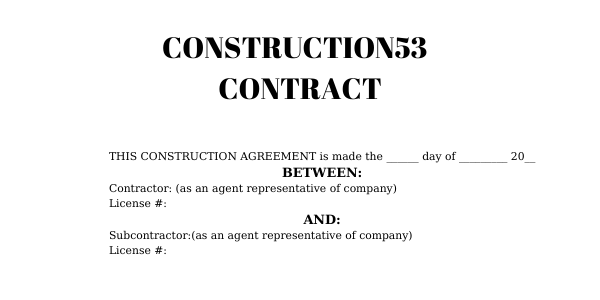The construction contract is the most important construction document. It has significant impacts on how costs are accounted for, especially in an open-book contract. It is a legal document that describes the rights and responsibilities of the parties, for example, the owner and the general contractor.
Five things must be aligned for a contract to exist:
- An offer to perform a service,
- An acceptance of the offer,
- Some conveyance, i.e. transfer of a completed building for money,
- A legal agreement, and
- Only authorized parties can sign the agreement, for example the officer-in-charge or chief executive officer (OIC or CEO).
The intent of the contractual agreement and the contract documents describe the completed project and the terms and conditions the parties (usually the project owner and the general contractor) must adhere to in order to accomplish the work. There typically is not a detailed description of the sequence of work or the means and methods to be used by the contractor in completing the project. The contractor is expected to have the professional expertise required to understand the contract documents and select appropriate subcontractors and qualified craftsmen, materials, and equipment to complete the project safely and achieve the specified quality requirements. For example, the contract documents will specify the dimension and sizes of structural steel columns and beams, but will not provide the design for erection aids, such as erection bolts or erection seats or hoisting and safety considerations.
The contract documents usually include at least the following five essential elements. They are listed here in what had been considered a relative order of precedence, but today most see them as complementary; all of these documents must work together:
- The contract agreement,
- Special or supplemental conditions,
- General conditions,
- Technical specifications, and Drawings.
The terms and conditions of the relationship between the primary parties are defined solely within the contract documents. These documents should be read and completely understood by the contractor before deciding to pursue a project. They also form the basis for creating a project estimate and schedule.
To manage a project successfully, the project manager must understand the organization of the contract documents and the contractual requirements for his or her project. This knowledge is essential if the PM has any expectation of satisfying the expectations of his or her company executives as well as that of the project owner.

The contract agreement itself is either a generic standard template or a specially prepared document to suit a specific project owner or a specific project. Most government agencies use standard formats for developing construction contract documents. Federal and state agencies typically have standardized general conditions and contract language. Many private owners use contract formats developed by the American Institute of Architects (AIA) or the new family of construction contracts called the Consensus Docs headed up by the Associated General Contractors of America (AGC) and other contractor associations. Contracts should not be signed until they have been subjected to a thorough legal review. This is to ensure that the documents are legally enforceable in the event of a disagreement and that there is a clear, legal description of each party’s responsibilities.
Standard contract agreements have typically been developed by attorneys and have been tested in the legal system and deemed fair to the parties that willfully execute them. The contract documents have a significant impact on the responsibilities of the jobsite project team and effect accounting processes. Specific requirements are contained in the general conditions and special conditions of the contract.
A particular project could utilize many potential combinations of delivery, procurement, pricing methods, contract formats, and contractor organizational structures as shown in Figure 3.5.

There are several different accounting implications or rules the contractor must adhere to which will be defined in the contract documents. Since they are closed-book they do not discuss reimbursable versus non-reimbursable costs. Open-book projects discuss at length what is cost-reimbursable and non-reimbursable. Reimbursable costs may include the project manager and cost accountant or cost engineer if they are stationed at the jobsite.
Reimbursable and non-reimbursable costs are defined in Articles 7 and 8 respectively in AIA contract A102 for cost-plus projects with a guaranteed maximum price. Labor burden rates and the owner’s right to audit the contractor’s books are defined in the open-book project contract along with allowable equipment rental rates and maintenance costs. Closed-book lump sum projects are not auditable and are not subject to these clauses and articles. Both closed- and open-book contracts will define change order markups in their contract as well. Excerpts from AIA A102 Articles 7 and 8 pertinent to how the project will be estimated and accounted for follow
Article 7, Costs to be reimbursed:
7.2.1: Wages of construction workers employed at the site (i.e. carpenters and laborers)
7.2.2: Salaries of supervisory personnel stated at the site (i.e. superintendent, project manager, and jobsite cost accountant)
7.2.4: Taxes, insurance, benefits for personnel (i.e. labor burden)
7.5.2: Rental charges for equipment
Article 8, Costs not to be reimbursed:
8.1.1: Salaries of personnel stationed at the office (i.e. CEO and accountants and marketing staff)
8.1.2: Expenses of the principal office, other than the site office
8.1.3: Home office overhead and general expenses
